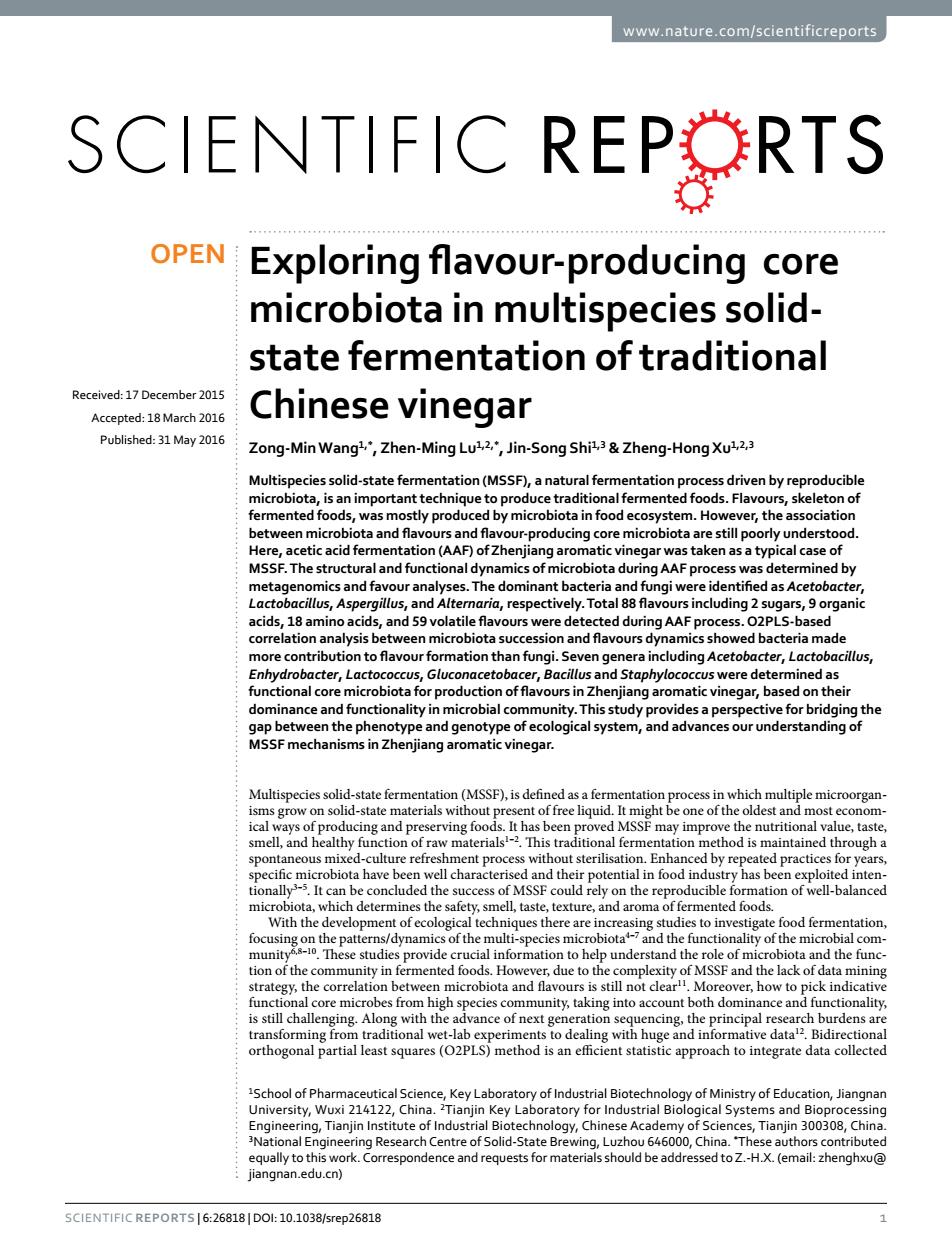正在加载图片...

www.nature.com/scientificreports SCIENTIFIC REPRTS OPEN Exploring flavour-producing core microbiota in multispecies solid- state fermentation of traditional Received:17 December 2015 Accepted:18 March 2016 Chinese vinegar Published:31 May 2016 Zong-Min Wang,Zhen-Ming Lu2,",Jin-Song Shi&Zheng-Hong Xu2.3 Multispecies solid-state fermentation(MSSF),a natural fermentation process driven by reproducible between microbiota and flavours and flavour-producing core microbiota are still poorly understood Here,acetic acid fermentation(AAF)of Zhenjiang aromatic vinegar was taken as a typical case of MSSF.The structural and functional dynamics of microbiota during AAFprocess was determined by metagenomics and favour analyses.The dominant bacteria and fungi were identified Lactobacillus,Aspergillus,and Alternaria,respectively.Total 88 flavours including 2 sugars,9 organic acids,18 amino acids,and 59 volatile flavours were detected during AAF process.O2PLS-based correlatio nalysis be tween microbiota s ssion and flavours dynamicssho wed bacteria made more contribution to flavour formation than fungi.Seven genera including Acetobacter,Lactobacillus, Enhydrobacter,Lactococcus,Gluconacetobacer,Bacillus and Staphylococcus were determined as functional core microbiotafor production of flavours,based on their dominance and.Thisstudy provides a perspective for bridging the gap between the phenotype and genotype of ecological system,and advances our understanding of MSSF mechanisms in Zhenjiang aromatic vinegar. Multispecies solid-state fermentation(MSSF),is defined as a fermentation process in which multiple microorgan isms grow on solid-state materials without present of free liquid.It might be one of the oldest and most econom- ical ways of producing and preserving foods.It has been proved MSSF may improve the nutritional value,taste, smell,and healthy function of raw materials-2.This traditional fermentation method is maintained through a spontaneous mixed-culture refreshment process without sterilisation.Enhanced by repeated practices for years, specific microbiota have been well characterised and their potential in food industry has been exploited inten- tionally3-5.It can be concluded the success of MSSF could rely on the reproducible formation of well-balanced microbiota,which determines the safety,smell,taste,texture,and aroma of fermented foods. With the develop are incr studies to investigate food fermentation. focu namics of the n 2 matio the of he microbialcom- ota and the fun commu microbio ta an core microbes from high species community,taking into account oth dominance and unctionality o can e and mfomane t Bidirectiona orthogonal partial least squares(O2PLS)method is an efficient statistic approach to integrate data collected 无卡P9二XOP5oh今 ogical Syste ute of Indu s and R ology,Chines jiangnan.edu.cn) SCIENTIFIC REPORTS |6:2681 D0:10.1038/srep26818Scientific Reports | 6:26818 | DOI: 10.1038/srep26818 1 www.nature.com/scientificreports Exploring flavour-producing core microbiota in multispecies solidstate fermentation of traditional Chinese vinegar Zong-MinWang1,* , Zhen-Ming Lu1,2,* , Jin-Song Shi1,3 & Zheng-HongXu1,2,3 Multispecies solid-state fermentation (MSSF), a natural fermentation process driven by reproducible microbiota, is an important technique to produce traditional fermented foods. Flavours, skeleton of fermented foods, was mostly produced by microbiota in food ecosystem. However, the association between microbiota and flavours and flavour-producing core microbiota are still poorly understood. Here, acetic acid fermentation (AAF) of Zhenjiang aromatic vinegar was taken as a typical case of MSSF. The structural and functional dynamics of microbiota during AAF process was determined by metagenomics and favour analyses. The dominant bacteria and fungi were identified as Acetobacter, Lactobacillus, Aspergillus, and Alternaria, respectively. Total 88 flavours including 2 sugars, 9 organic acids, 18 amino acids, and 59 volatile flavours were detected during AAF process. O2PLS-based correlation analysis between microbiota succession and flavours dynamics showed bacteria made more contribution to flavour formation than fungi. Seven genera including Acetobacter, Lactobacillus, Enhydrobacter, Lactococcus, Gluconacetobacer, Bacillus and Staphylococcus were determined as functional core microbiota for production of flavours in Zhenjiang aromatic vinegar, based on their dominance and functionality in microbial community. This study provides a perspective for bridging the gap between the phenotype and genotype of ecological system, and advances our understanding of MSSF mechanisms in Zhenjiang aromatic vinegar. Multispecies solid-state fermentation (MSSF), is defined as a fermentation process in which multiple microorganisms grow on solid-state materials without present of free liquid. It might be one of the oldest and most economical ways of producing and preserving foods. It has been proved MSSF may improve the nutritional value, taste, smell, and healthy function of raw materials1–2. This traditional fermentation method is maintained through a spontaneous mixed-culture refreshment process without sterilisation. Enhanced by repeated practices for years, specific microbiota have been well characterised and their potential in food industry has been exploited intentionally3–5. It can be concluded the success of MSSF could rely on the reproducible formation of well-balanced microbiota, which determines the safety, smell, taste, texture, and aroma of fermented foods. With the development of ecological techniques there are increasing studies to investigate food fermentation, focusing on the patterns/dynamics of the multi-species microbiota4–7 and the functionality of the microbial community6,8–10. These studies provide crucial information to help understand the role of microbiota and the function of the community in fermented foods. However, due to the complexity of MSSF and the lack of data mining strategy, the correlation between microbiota and flavours is still not clear11. Moreover, how to pick indicative functional core microbes from high species community, taking into account both dominance and functionality, is still challenging. Along with the advance of next generation sequencing, the principal research burdens are transforming from traditional wet-lab experiments to dealing with huge and informative data12. Bidirectional orthogonal partial least squares (O2PLS) method is an efficient statistic approach to integrate data collected 1 School of Pharmaceutical Science, Key Laboratory of Industrial Biotechnology of Ministry of Education, Jiangnan University, Wuxi 214122, China. 2Tianjin Key Laboratory for Industrial Biological Systems and Bioprocessing Engineering, Tianjin Institute of Industrial Biotechnology, Chinese Academy of Sciences, Tianjin 300308, China. 3 National Engineering Research Centre of Solid-State Brewing, Luzhou 646000, China. * These authors contributed equally to this work. Correspondence and requests for materials should be addressed to Z.-H.X. (email: zhenghxu@ jiangnan.edu.cn) received: 17 December 2015 accepted: 18 March 2016 Published: 31 May 2016 OPEN